The best air bikes are different from standard exercise bikes in a few key ways. First, they usually include elliptical-style handles that you push and pull in tandem with your pedaling, thus providing the kind of full-body workout you won’t find on most bikes. Second, air bikes are motorless — resistance is generated naturally by the fan at the front of the bike, which spins in accordance with your movements. Like curved treadmills, the harder you push, the harder the machine pushes back.
Though air bikes are easier on the joints than treadmills, their self-powered design makes for moderate- to high-intensity exercise that can be difficult to sustain over long periods. They are, however, perfect for quick and intense full-body workouts that can torch calories while strengthening the arms, glutes, quads, and core. You can browse our picks for the best air bikes below, but be forewarned: This may be the beginning of a love-hate relationship.
Best Air Bikes of 2023
- Best Air Bike Overall: Rogue Echo Air Bike
- Best Air Bike for Beginners: Assault Fitness Air Bike Classic
- Best Budget Air Bike: Titan Fan Bike
- Best Premium Air Bike: Bells of Steel Blitz Air Bike 2.0
- Best Heavy Duty Air Bike: Schwinn AD7
- Best Air Bike Without Arms: Concept2 Bike Erg
How We Tested the Best Mini Exercise Bikes
Believe us when we say that the athletes, certified personal trainers, and fitness enthusiasts at BarBend can get as winded on air bikes as casual riders. Over the years, we’ve put our feet to the pedals of various models, taking into account how they perform during moderate rides, high-intensity interval training (HIIT), and grueling sprints. What we found has helped us zero in on the key features one should look for in an air bike.
We tested more than a dozen different air bikes from a variety of brands, focusing on models that were designed to withstand the intensity that comes with sweat-drenched cardio bursts. As such, stability and durability were at the forefront of our minds, as were questions of ongoing maintenance and overall weight. We also considered the user experience, from the adjustability of the seats to the amount of noise generated by the fan. We also know budget is a factor, so we sought to provide options that won’t make it feel like your money’s been swept away in a gust of air.
Best Air Bike Overall: Rogue Echo Air Bike
Rogue Echo Air Bike
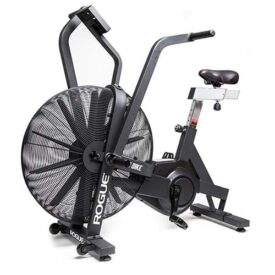
Specs
- Price: $795
- Weight Capacity: 330lbs
- Dimensions: 52.25’’ H x 55’’ L x 29.5’’ W
- Weight: 123lbs
Pros
- The Rogue Echo is forged from reinforced, powder-coated steel for a stable ride.
- Its belt-driven operation is quieter and requires less maintenance than chain-driven bikes.
- The padded seat has eight different height settings and five front-to-back settings.
- You can connect to fitness trackers and apps via Bluetooth or ANT+.
Cons
- It’s longer and wider than your average air bike by several inches, so those looking to save space may want a smaller model.
- There’s no storage for water bottles and phones.
Our pick for the best overall air bike is the Rogue Echo, which is one of the quieter models on the market thanks to its precision steel fan blades and the reinforced rubber belt of its drive system.
Our testernoted how the Echo’s reinforced, overbuilt steel frame makes it “sturdier than most” air bikes, adding that it reduces wobbling and swaying to give riders “a solid foundation for even the strongest of bursts.” Knurled 4.5-inch rotating foot pegs provide a place for your feet if you’re just in the mood to work your arms. The Echo also secures the bike with rubber leveling feet under each base tube. Rogue claims these can “adapt to your flooring” and help level the bike, even on uneven surfaces.
The bike can adapt to athletes of varying body types thanks to the seat’s eight different height settings and five front-to-back settings. The Echo’s latest model, the 3.0, improves upon its predecessor by moving the adjustment knob to the back of the seat post to help prevent loose clothing and headphone wires from catching on it. Unfortunately, there’s still nowhere to store your phone or water bottle.
The 3.0’s 5’’ x 8’’ console is larger than the 2.0’s 6.4” x 3.4’’ one, but you still won’t be able to stream any workouts on it. You can, however, connect it to Bluetooth and ANT+, thus allowing users to track their intervals, distance, calories burned, and more via compatible fitness trackers and apps. You can also link up the Echo with a heart rate monitor to take advantage of its Heart Rate Tracking mode, which accompanies the pre-loaded interval and target programs on the console.
The Echo, however, is one of the heaviest bikes on the market at 123 pounds. It’s also both longer and wider than the average air bike by several inches, so it may not be the best pick for those working out in tight spaces or equipment-clogged gyms. For some, though, wider and heavier air bikes are preferred, as they can provide a more stable base during moments of high intensity.
Read our full Rogue Echo Air Bike Review.
Best Air Bike for Beginners: Assault Fitness Air Bike Classic
Assault AirBike
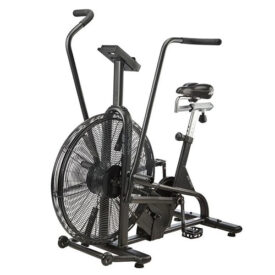
Specs
- Price: $699
- Weight Capacity: 300lbs
- Dimensions: 50’’ H x 50.95’’ L x 23.34’’ W
- Weight: 95.6lbs
Pros
- Beginners will like the seven different workouts pre-loaded into the bike’s console.
- It’s built to last with a durable, powder-coated steel frame and 20 sealed cartridge bearings.
- You can choose between six height options and move the seat forward and backwards.
- Its reinforced metal pedals are extra wide to cater to multiple foot sizes.
Cons
- The chain drive makes the Air Bike Classic louder than belt-driven air bikes.
- It has no built-in speakers or Bluetooth compatibility.
Switching from an elliptical or an electric exercise bike to an air bike can be daunting, but the Assault Air Bike Classic (also known as the AirBike) eases riders in with a series of interval programs and goal workouts to help them get comfortable.
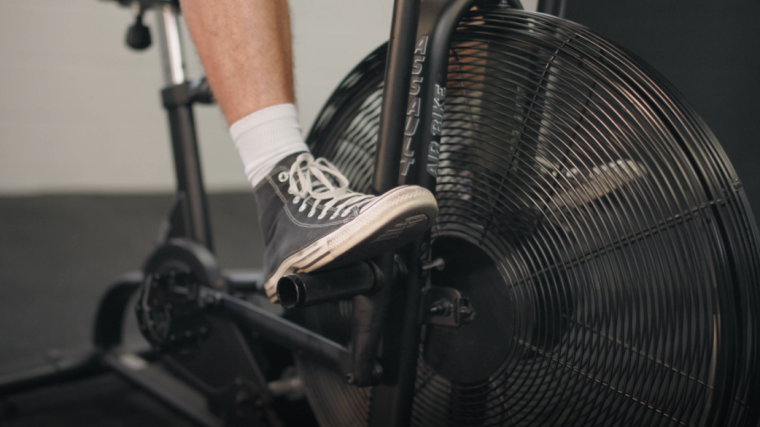
Since it’s powered by the intensity of your movements, the Airbike is capable of infinite resistance levels. This makes it ideal for beginners, who can start by setting their own pace and slowly ramp up over time. The bike is particularly useful for interval training, which you can get a taste of with the seven HIIT, Tabata, and stamina workouts available via the console.
The steel frame comes with a corrosion-resistant powder coat, and the extra-wide metal pedals have been reinforced for added durability. Its pivots and moving parts, meanwhile, have been fortified with 20 sealed cartridge bearings that work to prolong its life. According to our tester, the AirBike could “last decades” in a home gym with proper maintenance.
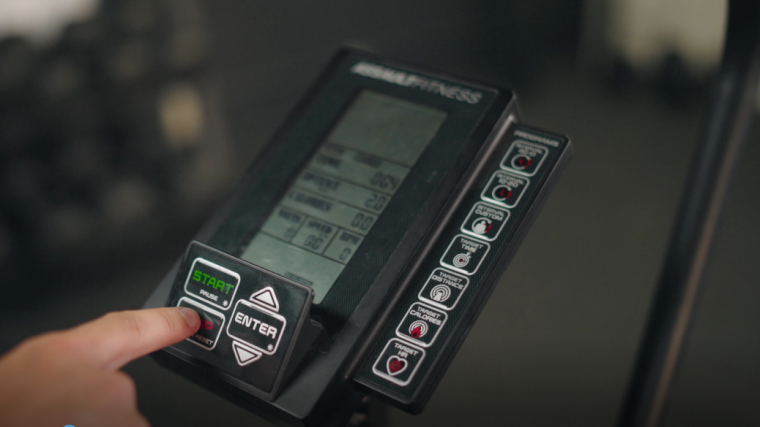
That said, the bike’s chain-driven operation is likely to be louder than what you’ll get from a belt-driven bike, so you’ll want to make sure nobody’s asleep nearby when you hop on. And if you like to watch TV as you ride, you’ll really need to crank up the volume.
Beginners may also like the bike’s low-tech design, which negates the need to fiddle with settings or levels — your workout begins when you start pedaling. There are no built-in speakers or Bluetooth compatibility. It does have a water bottle holder, but there’s nowhere to set your phone or tablet. The good news, though, is that its self-powered design requires no power, so you can set it up outside on sunny days. Moving it back inside is easy, too, thanks to its built-in transport wheels.
Whether you’re pedaling or posted up on its pegs for an upper-body workout, the AirBike will make you sweat. As BarBend’s Jake Herod says in the above video, “It tends to kick my butt every time I get on.”
Read our full Assault Air Bike Classic Review.
Best Budget Air Bike: Titan Fan Bike
Titan Fan Bike
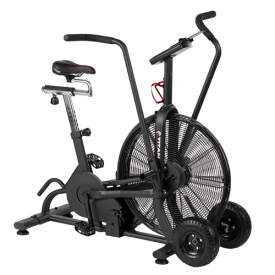
Specs
- Price: $699.99
- Weight Capacity: 330lbs
- Dimensions: 50’’ H x 50.5’’ L x 20.37’’ W
- Weight: 111lbs
Pros
- At just $699.99, this bike is roughly $100 to $200 cheaper than standard air bikes.
- It’s forged from powder-coated steel with sealed cartridge bearings in every pivot.
- You can link up heart rate monitors via Bluetooth.
- It’s got 10-inch turf tires and a knurled back handle for easy transport.
Cons
- Its chain-driven operation tends to be noisier than belt-driven bikes.
- The smartphone holder may be too small if your device is in a thick case.
Our pick for the best budget air bike is the Titan Fan Bike, which doesn’t compromise on quality despite costing roughly $100 to $200 less than the average air bike.
Unlike many bikes at its price point, the Titan Fan Bike comes with transport-friendly turf tires, knurled steel pegs and handles, a smartphone holder, and storage for water bottles and phones. It also includes an air shield that prevents the flywheel’s gust from blowing in your face.
At 111 pounds, it’s also surprisingly robust for its cost. Forged from heavy-duty steel with a corrosion-resistant powder coat, it fortifies its pivots with sealed cartridge bearings that can prolong the bike’s life and reduce its need for routine maintenance.
That said, this is a chain-driven bike, so you’ll still want to lubricate and check the tension of the chains on a monthly basis. It’s also worth noting that chain-driven bikes tend to be louder than air bikes that utilize a belt-driven system. As such, belt-driven bikes, on average, cost more than chain-driven ones.
If you can live with the noise, it’s likely you’ll be happy with the amount of power you can get out of the machine. As one five-star review puts it, “I love the effects and results I’m seeing because of the work. I love the price point for the quality of the machine. I love how easy the machine was to put together and how easy it is to adjust heights for different riders.”
Other reviews cite the bike’s usefulness for Crossfit-style workouts and hefty build. “It is a tad heavier… but also much more rugged,” reads one review.
After settling into its extra-wide padded seat, you can pedal at your own pace or choose from interval training and target-oriented modes via the high-contrast LCD display. In addition to logging time, distance, and calories burned, the display is also Bluetooth-compatible, so you can link up a heart rate monitor. A heart rate monitor isn’t included, but the bucks you’re saving on the bike may allow you to pick up one yourself.
Best Premium Air Bike: Bells of Steel Blitz Air Bike 2.0
Bells of Steel Blitz Air Bike 2.0
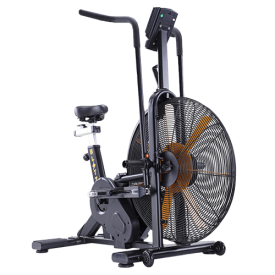
Bells of Steel Blitz Air Bike 2.0
Bells of Steel’s Blitz Air Bike 2.0 utilizes a belt-driven operation that’s quieter and requires less maintenance than chain-driven bikes. It also provides a handful of creature comforts, including rubber hand grips, a removable fan guard, and a seat with 10 different height adjustments.
Specs
- Price: $759.99
- Weight Capacity: 350lbs
- Dimensions: 51’’ H x 53’’ L x 23’’ W
- Weight: 118lbs
Pros
- The flywheel’s quiet, belt-driven operation requires little long-term maintenance.
- Its creature comforts include rubber hand grips, knurled foot pegs, and a removable fan guard.
- The seat has 10 height adjustments and can be moved forward and backwards.
- Its powder-coated steel frame and wide 23-inch feet work to reduce sway.
Cons
- It has no Bluetooth or ANT+ compatibility.
- The console’s lack of backlight can make it tough to read.
If you appreciate the finer things in life, you’ll find plenty to love about Bells of Steel’s Blitz Air Bike 2.0. It pampers the rider with rubber hand grips, storage for phones and water bottles, and a seat that can be adjusted up, down, forward, and back. Also, if you like the breeze in your hair, it’s got an extra-large 25-inch fan (with a removable guard) that can produce a lot of resistance.
A big fan doesn’t always mean a louder ride, however. The Blitz eschews the chain-driven operation you’ll find on many air bikes for a belt-driven one that works to reduce noise and provide smoother transitions, which is especially nice during interval training. Also, belt-driven air bikes tend to need less maintenance than chain-driven ones, which require routine lubrication.
Its premium features extend to its construction, which contains plenty of steel with a powder coat that can help resist rust and corrosion. It’s also got a pair of knurled foot pegs for those times you want to give your legs a rest and focus on the bike’s upper-body workout. The bike is heavy at 118 pounds, but it can support up to 350 pounds, which is above average for an air bike. Also, hefty bikes tend to have less sway than lighter ones, especially when you factor in the Blitz’s 23-inch wide feet.
Several reviews call out the bike’s solid build and quiet operation. “The belt drive is quiet, nothing squeaks, and the pedals and handles feel smooth. Going all out and the bike still feels sturdy,” reads one five-star review.
You can track RPM, speed, time, distance, calories, watts, and heart rate via the built-in console, which comes pre-loaded with target-oriented programs and ones designed to ease you into interval training. One feature it lacks, however, is Bluetooth and ANT+ compatibility, though you can link up a heart rate device that uses analog 5kHz frequency. Still, as one reviewer declared, the Blitz is a “real luxury to have in a home gym.”
Best Heavy Duty Air Bike: Schwinn AD7
Schwinn AD7
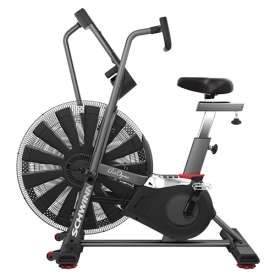
Schwinn AD7
The latest variation of Schwinn’s time-tested Airdyne model was designed with longevity in mind. The frame, which comes with a 10-year warranty, is forged from heavy-duty steel with a corrosion-resistant powder coat. The belt-driven flywheel, meanwhile, promises a quieter ride than you’ll find on chain-driven air bikes.
Specs
- Price: $899
- Weight Capacity: 350lbs
- Dimensions: 53’’ H x 53’’ L x 26.5’’ W
- Weight: 113lbs
Pros
- Schwinn has fortified its time-tested Airdyne with heavy-duty powder-coated steel that can withstand intense bouts of interval training.
- The bike’s 350-pound weight capacity is higher than what you’ll find on most air bikes.
- The belt-drive system can provide a smoother, quieter ride than air bikes with chain drives.
- The frame comes with a 10-year warranty.
Cons
- The console is pretty rudimentary and unable to stream video content.
- It’s not compatible with Bluetooth or ATN+.
The best cardio machines feel the same on your 500th run, ride, or row as they did on your first. The AD7, Schwinn’s latest variation on their time-tested Airdyne exerciser, has a sturdy steel frame and belt-driven operation that should last as long in your gym as the OG model, which was painted gold and had an analog “effort” monitor, did in your parent’s.
The frame’s steel construction comes with a corrosion-resistant powder coat and a 10-year warranty, which should provide some peace of mind as your arms and legs reap the benefits of HIIT, Tabata, and LISS workouts. Numerous five-star reviews call out the bike as “sturdy,” “strong,” and “very well built.” Though the frame has been praised by customers, others have noted the seat can be “wobbly” during rides.
Other reviews have expressed their surprise at how quiet the bike is. While air bikes tend to be loud, the AD7 trades out the chain drive you’ll find on many models for a rubber belt system that works to reduce noise and provide a smoother pedal. It’s still a good deal louder than electric cardio machines, but the AD7’s noise comes almost entirely from the fan, not the drive system.
We wish the console had a backlight that could better illuminate the stats it tracks, such as time, distance, speed, and calories burned. We do, though, like its interval and target-focused modes that can help acclimate you to HIIT and Tabata work. And if the rush of air generated by the fan bothers you, the AD7 comes with an air diverter that keeps it out of your face.
Best Air Bike Without Arms: Concept2 Bike Erg
Concept2 Bike Erg
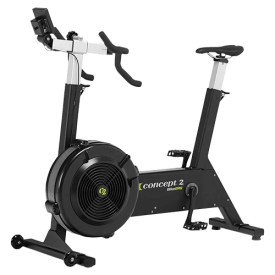
Concept2 Bike Erg
The lightweight Concept2 BikeErg eschews the moveable arms you’ll find on most air bikes, delivering a power-driven ride that operates more like a standard cycle than a spin bike. The flywheel’s unique damper allows riders to adjust airflow, which is akin to switching gears on a mountain bike.
Specs
- Price: $1,100
- Weight Capacity: 300lbs
- Dimensions: 40.5’’ H x 48’’ L x 24’’ W
- Weight: 68lbs
Pros
- Since there are no handles, this air bike is 10 to 12 inches smaller than most air bikes, making it a better fit for tight spaces.
- The flywheel’s adjustable damper can add resistance.
- It can connect to heart rate monitors and fitness apps with Bluetooth or ANT+.
- At 68 pounds, it’s lighter than standard air bikes by 30 to 50 pounds.
Cons
- You’ll need to get an upper-body workout elsewhere, as the BikeErg doesn’t have moveable arms.
- Several reviews note the seat isn’t as comfortable as they’d like.
If you want an air bike but lack the space or need for a full-body exerciser, Concept2’s BikeErg might be for you. Like any air bike, the harder you work, the harder it works. It just does so without the moveable handles you’ll find on most air bikes.
The BikeErg also stands out for its unique flywheel construction, which features a damper that works to replicate the gears of a mountain bike. Though you’re always in control of resistance, the damper adjusts airflow to the flywheel — opening it can feel like shifting into a heavier gear, while closing it can feel like dropping into a lower one. This makes the bike especially helpful for those who want to incorporate hill training into their air bike exercises.
“It’s not made to be a spin bike,” Concept2 representative previously told BarBend. “It has a wide range of dampers that allow you to set the cadence, or RPM, for your power or effort. It even has a clutch that allows it to freewheel like a real bike.”
Several customers appreciate this arm-less, flexible design. “It’s very similar to my mountain bike and is definitely a better workout than a traditional spin bike,” reads one five-star review. Other reviews, however, mention that the BikeErg’s seat was a touch too hard for their liking, and that they needed to purchase third-party cushions to wrap over it.
The BikeErg’s PM5 monitor comes pre-loaded with time-, distance-, and interval-based workouts, offering a wider range of options than you’ll find on the monitors of most air bikes. Since it’s compatible with Bluetooth and ANT+, you can also link it up to heart rate monitors and fitness apps like Zwift or Concept2’s own ErgData for more precise tracking.
How We Chose the Best Air Bikes
Though they can cost roughly the same as a standard exercise bike, air bikes often serve different purposes in a gym setting. While many standard bikes integrate luxuries like touchscreen displays, app integration, and device holders, air bikes tend to be more utilitarian in their design. Below are some of the key factors we considered when making our picks.
Construction
What air bikes lack in cutting-edge tech, they make up for in the quality of their construction. That makes sense, as air bikes are typically best suited for high-intensity workouts like HIIT training and sprint intervals. When you’re three sets deep into an interval workout, you’re likely not bringing a gentle touch to those pedals and handles.
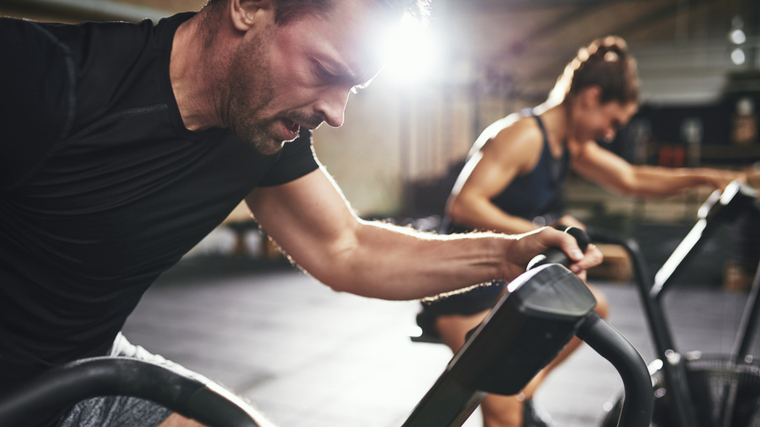
Our picks can take a beating. From their frames to their fan blades, the bikes on this list are made primarily from steel or aluminum and capable of supporting anywhere from 300 to 350 pounds. Several models also feature knurled steel pegs and rubber hand grips that provide additional stability. We also looked for models with powder coats resistant to rust and corrosion, which is a must when they’re likely to be drenched in sweat by the end of your ride.
Adjustability
Since air bikes work your arms and legs simultaneously, it’s important to get your body in the right position. When making our picks, we zeroed in on models with seats that can be adjusted in every direction — up, down, forward, and backwards — and handles with a variety of different grip points.
Weight
When it comes to air bikes, heavier tends to be better. Since they’re suited for intense bouts of HIIT and sprint workouts, the last thing you want is a machine that wobbles and sways as your limbs are pumping up, down, forward, and backwards. Heavier bikes of more than 100 pounds provide a more stable ride, especially when paired with a wide base, generally between 23 and 30 inches. Sure, that can make moving it a pain, but all of our picks include wheels — some even have turf tires — that help lighten the load.
Price
The price of air bikes can fluctuate between $600 and $1,300. On the whole, most air bikes on the market aren’t that different. The majority are constructed primarily of heavy–duty steel or aluminum and feature powder coats that work to ensure the frame won’t rust under your sweat. For many athletes, this kind of utilitarian design works. Most rides, after all, are quick and dirty.
We did want to provide a few luxury options, however. Though you’re not likely to find much in the way of tech on any air bike, the pricier options differentiate themselves in other ways. Belt drives, for instance, can cost more than chain drives, as they can last longer and make less noise. Other features that can drive up the price include storage options, rubber hand grips, air guards, and an expanded range of adjustability.
How Much Do Air Bikes Cost?
On average, air bikes cost between $600 and $1,300. This falls squarely in the middle of the range you’ll find for most standard exercise bikes, which can cost anywhere from a few hundred dollars to several thousand.
Pricier air bikes are going to be made of heavy-duty components like powder-coated steel, sealed cartridge bearings, and plus-size fans capable of producing loads of resistance. These models also tend to incorporate a belt-driven system rather than a chain-driven one, as rubber belts require less upkeep and make less noise than chains. On the whole, less expensive air bikes tend to be chain-driven and incorporate more plastic into their design.
It’s worth noting, however, that even the most expensive air bikes likely won’t feature much tech. While many luxury bikes feature touchscreen displays with streaming capabilities, air bikes tend to have LCD consoles that track basic metrics. Bluetooth and ANT+ compatibility is about as high-tech as you’re going to get.
Benefits of Air Bikes
Air bikes will make you sweat, but their benefits extend beyond their ability to torch calories. They can also complement strength training and provide a low-impact exercise alternative for those with limited mobility. Here are some of the main perks.
Full-Body Workout
Air bikes are essentially a motorless combo of your standard exercise bike and an elliptical, with a pair of handles that you push and pull as you pedal. Like those machines, they can deliver one heck of a cardio workout. Several studies have shown the bike’s effectiveness as a calorie burner and as a reliable way to boost your overall anaerobic and aerobic endurance. (1)(2)
But it would be reductive to view the air bike as just another cardio machine. Studies have shown that HIIT sessions twice a week with 15 to 45-second work intervals can also produce significant strength increases. (1)(3) According to one 2022 study, all that pushing and pulling can even result in gains for your back squat, bench press one-rep max, and overall pulling strength. (2) Whether you’re working to slim your waistline or tone your biceps, triceps, and shoulders, the air bike is an excellent machine to have in your home gym.
High-Intensity Training
Because air bikes instantly react to the amount of effort you put in, they’re an excellent way to practice high-intensity training and Tabata intervals consisting of short, intense bursts of work. Research has shown that HIIT workouts can be just as beneficial for cardiovascular health as longer, more moderate cardio sessions — also, you can save a little time. (3)
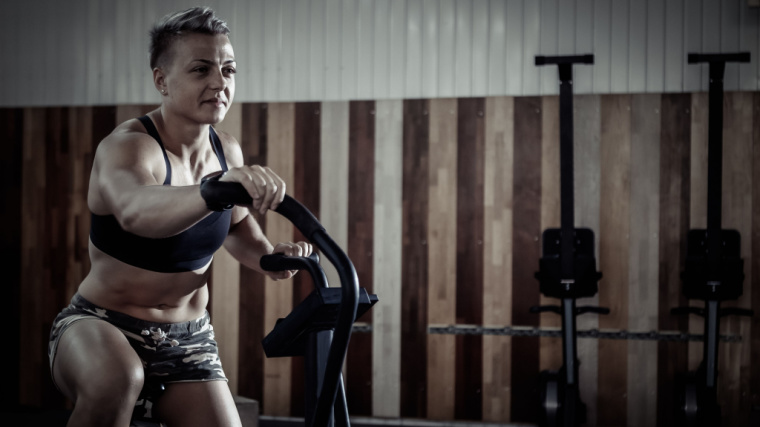
Air bikes can also be helpful during strength training. Since they work multiple muscle groups, you can use them to warm up your arms, shoulders, back, and legs before a workout. Some athletes, including many CrossFit enthusiasts, will hop on an air bike in between sets to keep their hearts pumping and push through bouts of physical and mental exhaustion.
Low-Impact Recovery
Though a few minutes on one can spike the heart rate of even the most seasoned athlete, the air bike’s user-controlled pace is also capable of a more moderate ride that can be suitable for seniors looking for a way to work their upper and lower body without aggravating their joints.
The air bike’s versatility can also come in handy for those recovering from an injury. If your knee or ankle is hurt, pop it on one of the pegs and focus on an arm workout. Similarly, you can still pedal when your arms or shoulders are in pain. And when it’s time to begin working an injured muscle again, the air bike is incapable of providing more resistance than it can handle. Studies have shown, after all, that cycling can be beneficial for those recovering from knee injuries. (4)
No Motor
Given that they require no electricity, air bikes are especially portable pieces of equipment. Since you don’t need to worry about power cords or outlets, they can be set up wherever you like, from your home gym to an exercise nook to your back patio. Furthermore, air bikes may last even longer than electrical exercise bikes, as you won’t need to worry about fraying wires or short-circuiting machinery.
What to Consider Before Buying an Air Bike
It might look like an amalgamation of an exercise bike and an elliptical, but air bikes tend to serve different purposes in the gym. Before dropping several hundred dollars on one, you’ll want to consider how your own fitness needs dovetail with its design and benefits.
Your Fitness Needs
Air bikes aren’t for everybody. Since there’s no motor to help you get started, it’s up to the rider to generate resistance in tandem with the bike’s fan. It’s a challenging workout and one that’s hard to sustain across long periods. If you’re more interested in leisurely, long-distance cycling than short, intense bursts of HIIT training, the air bike might not be for you. On the other hand, if you often find yourself lacking the time for an exhaustive workout, air bikes can make you sweat just as hard in a fraction of the time. (3)
Air bikes, however, do provide a full-body workout that can be effective for torching calories, burning fat, and building strength and muscle. (2) And since you can generate a lot of resistance very quickly, they can also be helpful in training yourself to push past physical exhaustion and build mental toughness. Many athletes, for example, utilize air bikes to punctuate strength sets with punishing sprints on the air bike. If you’re looking to push yourself and break barriers in your fitness training, an air bike can help you get there.
Belt vs. Chain
In lieu of electricity, air bikes are powered by a combination of effort and air resistance. That said, something’s still got to connect the pedals to the fan. In the case of air bikes, that’s either a belt or chain drive.
Chain drives are similar to what you’ll find on a standard bicycle and will better evoke the experience of riding outside. They do, however, require routine maintenance, whether that’s in servicing or lubricating the chain. Belt drives, on the other hand, require less maintenance and are said to be more durable. And since belt-driven bikes produce no rattle or clang, they tend to make less noise than chain-driven bikes. They often cost more, however.
Noise
As we just noted, belt-driven air bikes typically make less noise than chain-driven bikes, which can produce a metallic rattle in the same way as a standard bicycle. Still, no matter which model you choose, air bikes are going to make more noise than most cardio machines.
This is because air bikes generate resistance via a spinning fan, and the rush of air pushing against the fan blades results in a dull roar. The harder you pedal, the louder that rush of air gets. When you’re pushing hard, the noise can be equivalent to a vacuum cleaner. During lighter sessions, the sound is akin to white noise. Obviously, this can be disruptive to family and roommates if you like to pedal early or late. It can also drown out any shows or classes you may be streaming as you work out. If that’s an issue for you, it might be best to go for a standard exercise bike.
Cost
Air bikes can cost anywhere from $600 to $1,300, but the majority tend to cost somewhere between $700 and $900. If you’re simply looking for an air bike with a solid build that can handle HIIT and sprint intervals, you’d probably be happy with one of the more utilitarian models.
That said, you’ll want to ask yourself a few other questions before opening up your wallet. Is noise a concern? You may want a belt-driven bike rather than a chain-driven one. Do you like tracking your progress via apps or fitness trackers? Bluetooth compatibility is a must. Is a place for your water bottle or iPad a necessity? Not every bike has one, so weigh your priorities and choose wisely.
Final Word
Air bikes provide a full-body workout that can burn calories, strengthen your arms, and push through physical and mental blocks. It can be daunting at first, given that the bike’s motorless design generates resistance based on your own output. Once you get the hang of it, though, it can quickly become a go-to machine for warming up, cooling down, high-intensity cardio bursts, and full-body conditioning.
Your average air bike is a relatively simple machine with a sturdy frame, a fan, pedals, and a pair of moveable arms. That said, there are still a number of factors to consider before buying one. Are you concerned about how much noise it makes? Is cutting-edge tech something you want in your cardio equipment? How much are you willing to spend? No matter your answers, we’re confident our picks have an air bike that’s right for you.
FAQS
How are air bikes different from exercise bikes?
Think of air bikes as a combination of an exercise bike and an elliptical. In addition to pedals, air bikes usually have a pair of moveable arms that you push and pull as you pump your legs.
Air bikes are also different from standard exercise bikes in that they’re motorless, relying on wind resistance generated by the bike’s attached fan, which is propelled by the force of your own pedaling. The harder you pedal, the more resistance is generated.
What’s the best air bike?
The Rogue Echo is one of the most beloved models on the market for a reason. Forged from reinforced, overbuilt steel with a powder coat, it provides plenty of stability during intense HIIT and sprint intervals. It’s also one of the quieter air bikes on the market, utilizing a reinforced rubber belt in its drive system that makes less of a racket than the chains you’ll find in many air bikes. It’s one of the largest and heaviest air bikes on the market, but that’s often seen as a plus — the heftier an air bike is, the less it sways as you ride.
Are air bikes loud?
Since they’re powered by wind resistance, air bikes tend to be louder than most other cardio machines. Some, however, are quieter than others. Belt-driven bikes, for example, make less noise than chain-driven ones, though they do tend to cost more. Generally, air bikes produce a sound akin to white noise, though it can evoke the roar of a vacuum cleaner during sprints. So long as you’re biking at reasonable hours, the sound should be manageable for neighbors and roommates.
References
- Browne, J. D., Carter, R., Robinson, A., Waldrup, B., Zhang, G., Carrillo, E., Dinh, M., Arnold, M. T., Hu, J., Neufeld, E. V., Dolezal, B. A. (2020). Not All HIFT Classes Are Created Equal: Evaluating Energy Expenditure and Relative Intensity of a High-Intensity Functional Training Regimen. International Journal of Exercise Science. 13(4):1206-1216.
- Schlegel, P., Křehký, A., Hiblbauer, J. (2022). Physical fitness improvement after 8 weeks of high-intensity interval training with air bike. Sports Medicine. 10.13140/RG.2.2.21669.58081.
- Moghaddam, M., Cervantes, M., Cheshier, B., Jacobson, B. H. (2023). Sprint Interval Training on Stationary Air Bike Elicits Cardiorespiratory Adaptations While Being Time-Efficient. Journal of Strength and Conditioning Research. 37(9), 1795-1801.
- De Azevedo Franke, R., Rodrigues, R., Geremia, J. M., Teixeira, B. C., Boeno, F., Rabello, R., Baroni, B. M., Lima, C. S. (2021). Moderate intensity cycling is better than running on recovery of eccentric exercise-induced muscle damage. Physical Therapy in Sport. 50, 65-73.
The post The 6 Best Air Bikes of 2023 appeared first on BarBend.

